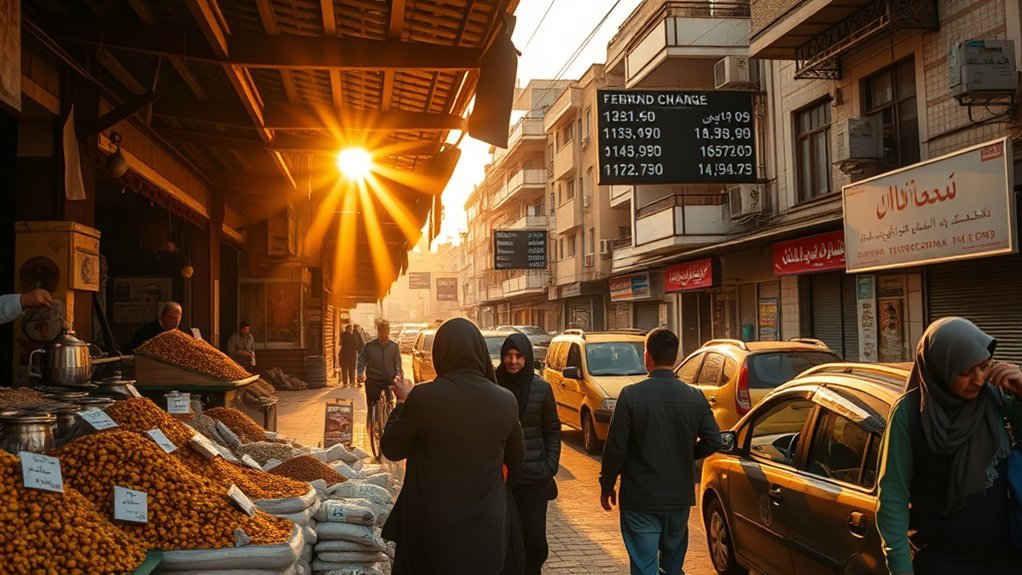Living in Iran is relatively affordable but varies widely by city and subsidies: you’ll pay about $300–$425 for a one‑bedroom rent in Tehran, $10–$35 monthly for utilities, $6 for a transit pass, and groceries that can keep a couple under $30 monthly if you buy locally. Average net wages hover near $264, with private health plans under $50/month. Costs rise in northern districts and for private schools — keep going to see detailed breakdowns and saving strategies.
Housing Costs and Rental Market in Iran
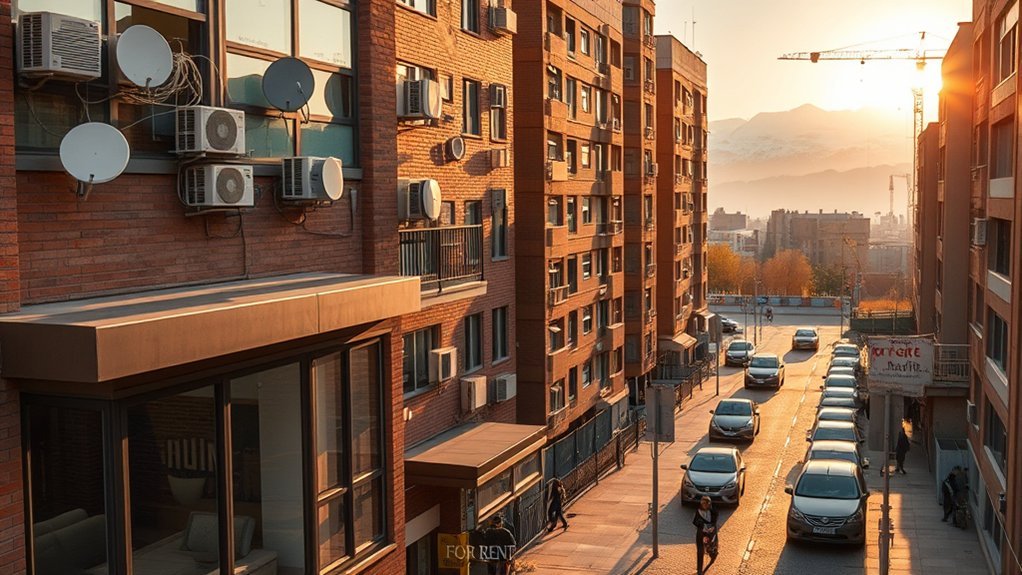
Although Tehran’s housing market varies widely by neighborhood and quality, you should expect significant upfront and ongoing costs: average rent for a 1‑bedroom in the city center is about $425.52 (roughly $304.53 outside the center).
Northern districts often demand large down payments of $15,000–$20,000 with monthly rents between $250 and $1,000.
Purchase prices span from roughly $50,000 for lower‑quality units to $1 million for high‑end properties.
Basic utilities for an 85 m² apartment run about $15/month and internet (50 Mbps+) around $11.10, but advertised rents frequently understate current market levels due to inflation and broader economic pressures.
You should treat housing costs as both a household expense and a policy variable: deposit requirements and price dispersion concentrate risk in wealthier neighborhoods, while market distortions and underpriced listings mask true demand.
You’ll need to budget for large initial outlays if targeting northern districts, and factor in rapid price shifts when comparing rental versus purchase options.
Food Prices and Grocery Shopping

When you compare typical grocery costs and eating-out prices in Iran, the data show staples like eggs, tomatoes and bread for two can cost about $3 while a full month of groceries is sometimes reported near $30.
Eating out is also inexpensive by international standards, with a mid-range meal for two around $18.50 and fast-food meals about $4.25.
Coffee and non‑alcoholic beverages (cappuccino ≈ $1.19, draft beer ≈ $0.70) further lower daily food-service expenses.
Typical Grocery Costs
A monthly grocery budget for two people in Iran can be as low as about $30, reflecting generally affordable local food prices driven by domestic production and subsidized staples.
Basic items like eggs, tomatoes and bread may cost roughly $3 for two, while dining options remain inexpensive with mid-range meals around $18.50, fast-food combos near $4.25, and a 0.5 L domestic non‑alcoholic beer at about $0.70.
For planners evaluating typical grocery costs, that data shows staples dominate expenditures and policy on subsidies matters more than discretionary spending.
You can expect low per-unit prices for locally produced fruit, vegetables and grains, but variability exists across cities and markets.
Budget strategies include buying seasonally, using local markets, and monitoring subsidy changes to maintain steady food security.
Eating Out Prices
One mid-range meal for two runs about $18, so when you’re planning food budgets you should treat dining out as a discretionary expense influenced by income, subsidies and location.
Eating out prices vary: mid-range dinners typically range $12–$50, while fast-food McMeals cost roughly $3.50–$5 (around $4.50 median).
Policy and subsidy distortions make local produce and staples comparatively cheap; basic groceries for two—eggs, tomatoes, bread—can total about $3, and some households report managing monthly groceries near $30.
Given that a three-course restaurant meal often exceeds $10, you’ll find dining out classified as luxury spending for many residents.
Use these data to model scenarios: allocate limited discretionary income toward occasional restaurant meals, prioritize subsidized staples, and monitor regional price variance.
Transportation and Commuting Expenses
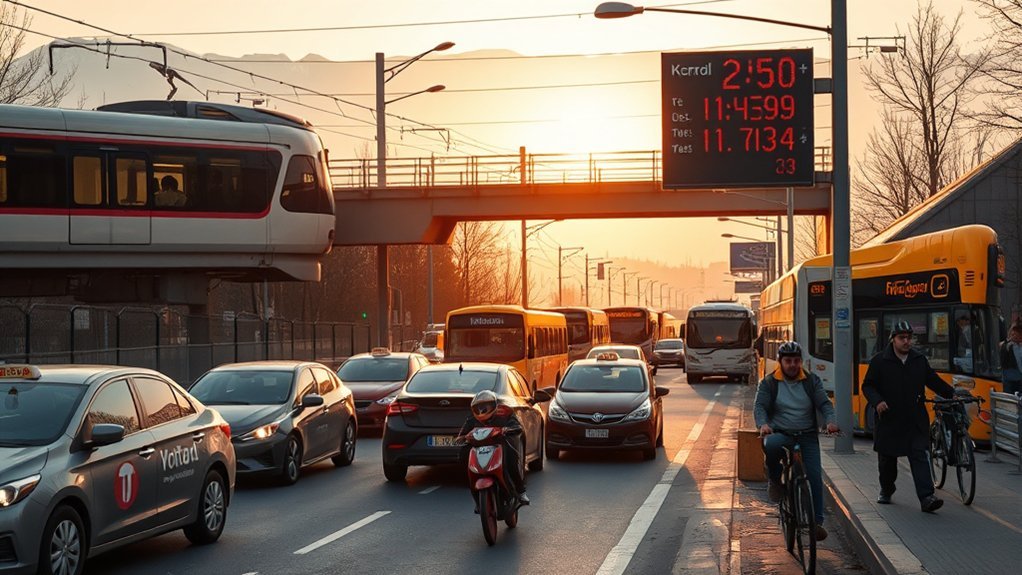
Although public transit remains heavily subsidized, you’ll find commuting in Iran is very affordable by international standards: a single local ticket runs about $0.18, a monthly pass roughly $6.00, and metro fares stay under $1, while taxis start near $0.40 with an 8 km ride averaging $2.89 and gasoline around $0.65 per liter, all of which keep both daily and monthly mobility costs low for residents. You’ll notice policy choices keep fares low to support labor mobility and urban access. Snapp expands point-to-point options, complementing subsidized buses and metros. If you drive, fuel subsidies reduce per-kilometer costs; if you ride, cheap monthly passes cap commuting expenditure. Consider modal split: metros for dense corridors, buses for coverage, taxis and Snapp for off-peak or last-mile. Fiscal sustainability remains a concern if subsidies persist without efficiency gains. Use the table below to compare typical costs and assess budgeting impact.
| Item | Typical Cost |
|---|---|
| Local ticket | $0.18 |
| Monthly pass | $6.00 |
| 8 km taxi | $2.89 |
| Gasoline (per L) | $0.65 |
Utilities, Internet, and Household Services
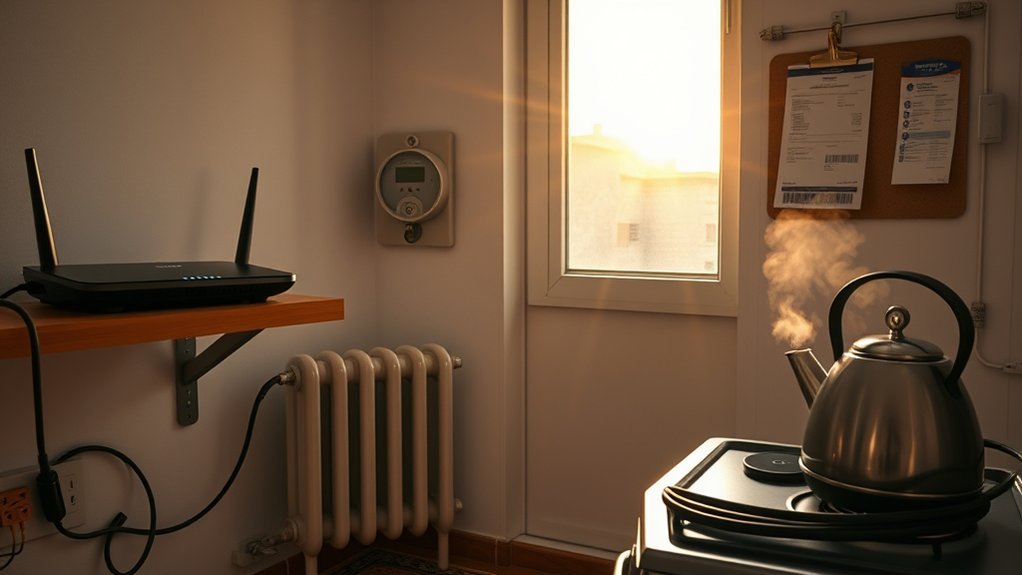
When you budget for an 85m² apartment in Iran, plan for basic utilities averaging $14.93 monthly (range $10–$35), though reported actuals can be about 25% lower.
Internet plans (60 Mbps+, unlimited) cost roughly $5.90 per month (range $2–$10) and mobile plans with 10GB+ run about $1.97 (range $1–$4), so connectivity is a modest line item.
Use these figures to assess household service policies and predict monthly expenditures, noting the average per-person utility estimate of ~$14.20.
Utilities Monthly Costs
Utilities in Iran remain inexpensive compared with many countries, and you’ll typically pay very little for basic services: combined electricity, heating, cooling, water, and garbage for an 85 m² apartment averages about $14.93/month (range $10–$35).
A high‑speed unlimited internet plan (60 Mbps+) runs roughly $5.90/month ($2–$10) and a mobile plan with calls plus 10+ GB costs about $1.97/month ($1–$4).
Reported real‑world expenses are often ~25% below these averages, bringing typical total monthly utility outlays to approximately $14.20.
Focus on utilities monthly costs when budgeting: subsidies and regulated tariffs drive low nominal bills, but local variations and seasonal demand affect consumption.
Plan for modest contingency and monitor meter readings to avoid surprises.
Internet and Plans
Having covered typical monthly bills, let’s look specifically at internet service: plans offering 60 Mbps or more with unlimited data average about $5.90/month (range $2–$10), making broadband one of the most affordable household services in Iran.
You’ll find that internet affordability supports digital inclusion goals and lowers barriers for remote work, education, and e-government uptake.
In Tehran, combined household telecom expenditures remain modest: a mobile plan with 10GB+ runs about $1.97/month ($1–$4), while basic utilities for an 85m² apartment average $14.93/month ($10–$35).
Reported utility costs being roughly 25% below listed averages suggests actual living costs may fall further.
When planning relocation or policy interventions, account for these lower effective prices and urban variations in living in Tehran.
Healthcare and Medical Costs

Although Iran’s healthcare system faces structural challenges, public insurance subsidies keep out-of-pocket costs low for most citizens, making care broadly affordable. Private plans under $50 per month can further reduce personal spending while specialized surgeries remain comparatively costly.
You’ll find healthcare integrated into cost of living calculations because subsidized primary care and medicines sharply lower household medical spending. If you enroll in public schemes, routine visits, vaccinations and chronic-disease management are heavily supported, so your annual direct medical outlay is modest compared with Western norms.
Adding a private plan (typically under $50 monthly) gives faster access and expanded coverage for diagnostics and elective procedures. Note that complex surgical interventions can still generate significant bills, so check benefit limits and referral requirements.
Systemic weaknesses — supply bottlenecks and uneven regional service quality — affect access more than price. In policy terms, Iran’s mix of public subsidy and low-cost private insurance delivers broad affordability and drives a life expectancy near 77.7 years, informing realistic budgeting for residents.
Salaries, Taxes, and Typical Incomes

Healthcare subsidies shape household budgets, but income and tax structures determine how much disposable cash you actually have. The average monthly net salary in Iran is about $264 after tax, a clear baseline for policy comparison and household planning.
Income taxes function similarly to Western systems and represent a material deduction from gross pay; tax compliance is uneven because a large cash-based economy complicates reporting. You’ll see tax breaks for certain professions, particularly doctors, which affects effective take-home pay and sectoral inequality.
Even top jobs and many public office positions typically pay under $1,000 monthly, so wage dispersion is limited compared with high-income countries. For budgeting, that means public transfers and subsidies — especially on healthcare — play a significant role in preserving consumption.
From a policy perspective, addressing informality, broadening the tax base, and targeting exemptions would increase revenues and could reduce reliance on subsidies while protecting low-income households.
Education and Childcare Expenses
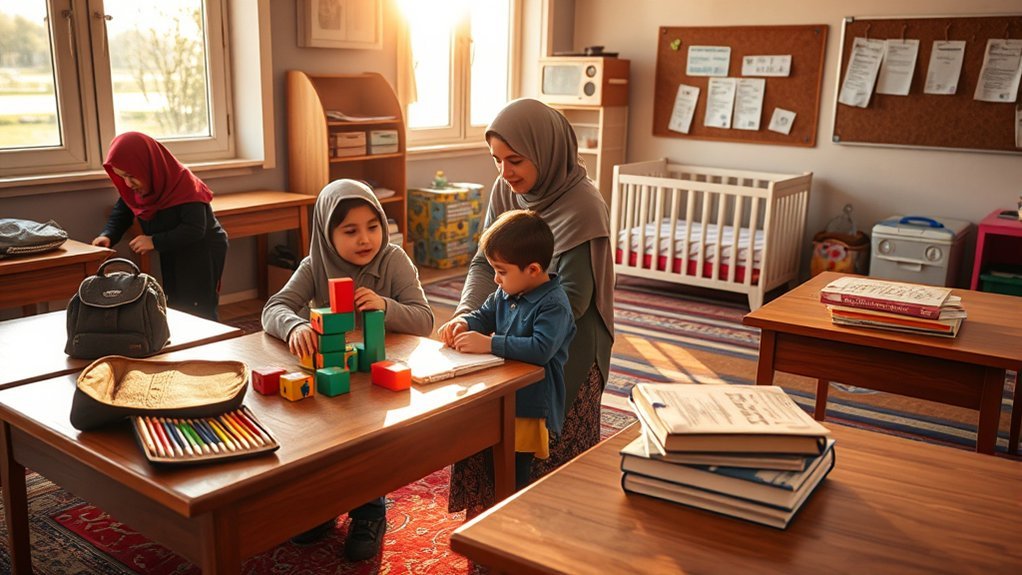
Because public schools cover most basic costs, families often face choice-driven expenses when they want higher perceived quality or specialised services, and those choices materially affect household budgets.
You’ll find that core education is publicly funded and largely free, but private schooling runs roughly $100–$1,500 per year depending on reputation and curriculum, so opting out of the public system is a deliberate, budget-sensitive decision.
University tuition for locals is low (about $200–$500 annually), which cushions long-term education spending unless you’re an international student facing higher rates.
Childcare costs for private nurseries average $50–$200 per month, with higher urban prices reflecting service intensity.
Expect supplementary costs: extracurriculars and tutoring typically add $20–$100 per month per child, and families spend $50–$100 monthly on supplies.
From a policy perspective, these figures show a dual system where public provision reduces baseline fiscal pressure but choice-driven private services and childcare costs create significant variation in household expenditure.
Entertainment, Dining Out, and Leisure
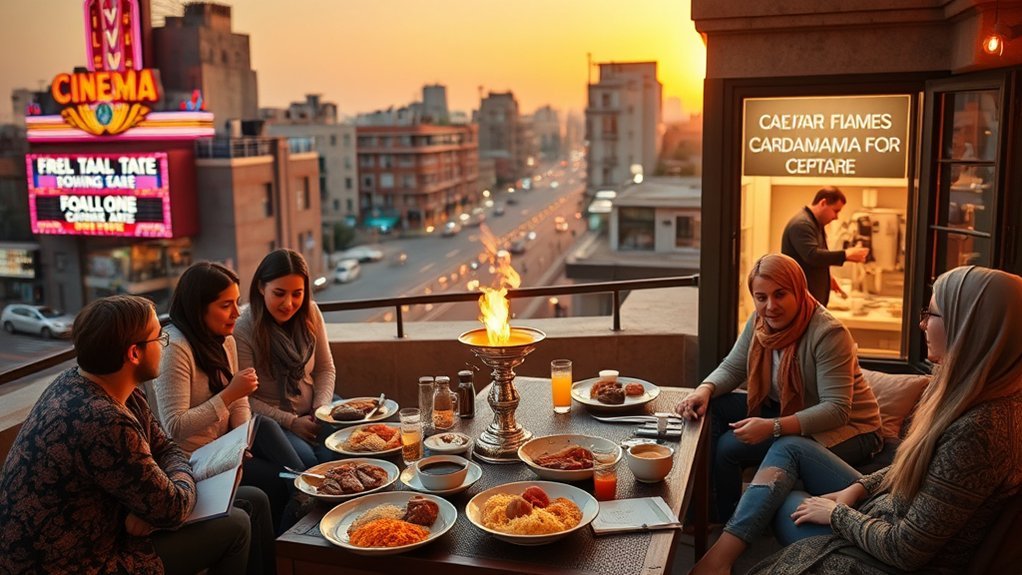
While public leisure options remain affordable, your discretionary spending on entertainment and dining can vary widely depending on choices and location; a mid-range restaurant meal for two averages about $18 (commonly $12–$50), fast-food meals run near $4.50, and a cappuccino costs roughly $1.06.
However, many households still treat eating out as a luxury given local income levels and reported grocery budgets as low as $30 per month. You’ll find that entertainment provision—cinemas, parks, cultural sites—often remains low-cost or state-subsidized, which cushions household leisure budgets.
However, commercial leisure activities and branded dining escalate expenditures quickly in urban centers. When planning household budgets or forming local policy, account for this split: baseline public entertainment reduces inequality in access, while private-sector prices create consumption gaps.
Your spending patterns will consequently reflect income and urbanization: lower-income families rely more on public leisure and home-prepared food, while higher-income households absorb restaurant and café costs, widening consumption-based lifestyle differences.
Tips for Saving Money While Living in Iran

If you want to cut costs without sacrificing basic living standards, prioritize home cooking, public transport, and local markets—groceries for a month can be managed for as little as $30 compared with regular restaurant spending. A one-way transit fare is about $0.18 (monthly passes near $6), and local brands typically undercut imported goods.
Combine these consumption choices with enrollment in public health insurance and housing outside city centers (one-bedroom rents can drop to roughly $305) to realize immediate, measurable reductions in household expenditure. You should track spending categories, set targets, and shift consumption toward less expensive substitutes: seasonal produce, bulk staples, and domestic brands.
Use public clinics and subsidized insurance to lower health outlays. Choose neighborhoods with lower rents and factor commuting costs into housing decisions. Policy-savvy choices—using subsidies, tariffs, and market cycles—help you optimize purchasing power.
Regularly review expenses against benchmarks and adjust behavior to sustain savings without eroding living standards.
Frequently Asked Questions
Is 100 USD a Lot in Iran?
No, $100 isn’t a lot in Iran; your Purchasing Power is limited versus average after-tax salary (~$264). It can cover basic monthly expenses with strict budgeting, but won’t support comfortable living or many discretionary costs.
Is Iran a Cheap Place to Live?
Yes — you’ll find Iran relatively cheap. Cost Comparison shows monthly living around $608, rent and basics particularly lower than global averages; policy-makers note affordable housing and transport, but regional variations and inflation affect real purchasing power.
How Much Does Rent Cost in Iran?
You’ll pay about $300–$425 on average for a 1‑bedroom; Rent ranges $150–$800 depending on location. The Rental Market shows high deposit demands in northern Tehran and significant urban vs. suburban price disparities.
What Is the Average Income in Iran in US Dollars?
You’ll see modest means: average income in Iran is about $264 monthly net; Income Comparison shows many professionals earn under $1,000, typical citizens make around $300, shaping data-driven, policy-focused discussions on living standards.
Conclusion
Overall, living in Iran can be affordable if you align choices with local incomes and policies: average rents, food, transport, utilities and healthcare are lower than many Western cities but vary sharply by city and sanctions-driven inflation. You might object that prices are unstable — they are — yet indexing budgets to local wages, using public transport, and leveraging subsidies or informal markets keeps real costs manageable. Policy-aware planning cuts risk and protects living standards.

